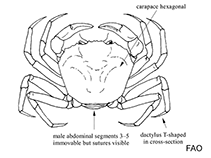Chaceon notialis Manning & Holthuis, 1989
Southwest Atlantic red crab| Native range | All suitable habitat | Point map | Year 2050 |

|
| This map was computer-generated and has not yet been reviewed. |
| Chaceon notialis AquaMaps Data sources: GBIF OBIS |
Google image | No image available for this species;
drawing shows typical species in Geryonidae.
Classification / Names Common names | Synonyms | CoL | ITIS | WoRMS
Malacostraca | Decapoda | Geryonidae
Environment: milieu / climate zone / depth range / distribution range Ecology
Benthic; depth range 120 - 1000 m (Ref. 106413). Deep-water; 31°S - 55°S, 69°W - 49°W
Distribution Countries | FAO areas | Ecosystems | Occurrences | Introductions
Southwest Atlantic: from Rio Grande do Sul, Brazil to 55°S in the Atlantic Magellan Province.
Length at first maturity / Size / Weight / Age
Maturity: Lm 7.0, range 9 - ? cm Max length : 13.5 cm CW male/unsexed; (Ref. 2689)
Life cycle and mating behavior Maturity | Reproduction | Spawning | Eggs | Fecundity | Larvae
Main reference
References | Coordinator | Collaborators
Manning, R.B. and L.B. Holthuis 1989 Two new genera and nine new species of geryonid crabs (Crustacea, Decapoda, Geryonidae). Proc. Biol. Soc. Wash. 102(1):50-77. (Ref. 2689)
IUCN Red List Status
(Ref. 130435: Version 2025-1)
CITES status (Ref. 108899)
CMS (Ref. 116361)
Threat to humans
Human uses
Fisheries: commercial
| FishSource | Sea Around Us
Tools
More information
Max. ages / sizes
Length-weight rel.
Length-length rel.
Length-frequencies
Mass conversion
Abundance
Internet sources
BHL | BOLD Systems | CISTI | DiscoverLife | FAO(Publication : search) | Fishipedia | GenBank (genome, nucleotide) | GloBI | Gomexsi | Google Books | Google Scholar | Google | PubMed | Tree of Life | Wikipedia (Go, Search) | Zoological Record



